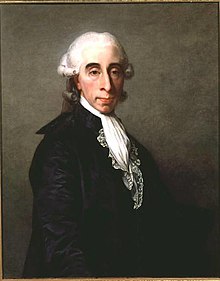Jean Sylvain Bailly
| Jean Sylvain Bailly | |
|---|---|

|
|
| 1st Mayor of Paris | |
|
In office 15 July 1789 – 18 November 1791 |
|
| Preceded by | Jacques de Flesselles (Provost of the Merchants) |
| Succeeded by | Jérôme Pétion de Villeneuve |
| 1st President of the National Constituent Assembly | |
|
In office 17 June 1789 – 3 July 1789 |
|
| Preceded by | Office established |
| Succeeded by | Jean Georges Lefranc de Pompignan |
| Deputy of the Estates-General | |
|
In office 5 May 1789 – 9 July 1789 |
|
| Constituency | Paris |
| Personal details | |
| Born |
15 September 1736 Paris, France |
| Died | 12 November 1793 (aged 57) Paris, France |
| Cause of death | Guillotined |
| Nationality | French |
| Political party | Patriotic (1790–1791) |
| Residence |
Paris (1736–1791) Nancy (1791–1793) |
| Alma mater |
Academy of Sciences French Academy |
| Profession | Astronomer, mathematician, politician |
| Religion | Roman Catholicism [source needed] |
| Signature |  |
Jean Sylvain Bailly (French: [bɑji]; 15 September 1736 – 12 November 1793) was a French astronomer, mathematician, freemason, and political leader of the early part of the French Revolution. He presided over the Tennis Court Oath, served as the mayor of Paris from 1789 to 1791, and was ultimately guillotined during the Reign of Terror.
Born in Paris, Bailly was the son of Jacques Bailly, an artist and supervisor of the Louvre, and the grandson of Nicholas Bailly, also an artist and court painter. As a child he originally intended to follow in his family's footsteps and pursue a career in the arts. However, he became deeply attracted to science, particularly astronomy, by the influence of Nicolas de Lacaille. An excellent student with a "particularly retentive memory and inexhaustible patience", he calculated an orbit for the next appearance of Halley's Comet (in 1759), and correctly reduced Lacaille's observations of 515 stars. He participated in the construction of an observatory at the Louvre. These achievements along with others got him elected to the French Academy of Sciences in 1763. In the years prior to the French Revolution, Bailly's distinctive reputation as a French astronomer led to his recognition and admiration by the European scientific community. Due to his popularity amongst the scientific groups, in the year of 1777, Bailly received Benjamin Franklin as a guest in his house in Chaillot.
Bailly published his Essay on The Theory of the Satellites of Jupiter in 1766. The essay was an expansion of a presentation he had made to the Academy in 1763. He later released the noteworthy dissertation On the Inequalities of Light of the Satellites of Jupiter in 1771. In 1778, he was elected a foreign member of the Royal Swedish Academy of Sciences.
...
Wikipedia
